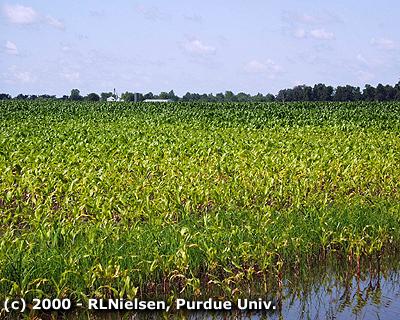Is the drought over for this year? According to both the National
Drought Mitigation Center (Drought
Monitor - 6/27/00) and the Climate Prediction Center (Palmer Drought Severity Index -
6/24/00), Indiana is drought-free for the first time in this millenium.
 Certainly the recent rains
across the state have helped us forget about drought stress for the time being.
In fact, quite a number of corn fields are instead suffering from the effects
of soggy soils on root health.
Certainly the recent rains
across the state have helped us forget about drought stress for the time being.
In fact, quite a number of corn fields are instead suffering from the effects
of soggy soils on root health.
An earlier article shared my thoughts on the effects of flooding and ponding on corn survival. After walking a number of fields since then, it seemed appropriate to share some additional observations on the effects of soggy soils on crop health.
The consequences of ponding or saturated soils on corn health can be astounding in late June when temperatures are in the 80's. In fact, some folks call and ask how can corn be so dramatically stunted in so short a period of time?
Well, first of all, some areas have been soggy off and on for weeks now. The saturated soil effects didn't just happen overnight. The accumulated stress of chronic 'wet feet' takes a greater toll on root health than does a single soggy event.
Secondly, not only are we seeing the effects of nitrogen loss (denitrification or leaching) on overall corn appearance in the soggy areas, but the plants' roots are also literally dying from the lack of soil oxygen. These two factors together are very damaging to the health of a corn crop. Consequently, one will often find a blurred mixture of true nitrogen deficiency and plain old leaf death from dying roots among plants in soggy areas.
Thirdly, the effects of soggy soils are protracted in poorly drained no-tilled fields with significant levels of surface trash. Surface trash limits soil evaporation and extends the time period within which the soils remain saturated. Corn health can deteriorate amazingly fast under such conditions.
Fourthly, some hybrids simply have a lower tolerance to 'wet feet' than others. Unfortunately, few, if any, companies rate their hybrids for such tolerance. Even they did, Murphy's Law says that hybrids tolerant to soggy soils would probably be susceptible to drought conditions!
Finally, another factor related to the apparent rapid deterioration of corn in soggy areas is that the corn growing outside of those areas continues to grow normally. In fact, given the warm temperatures of late plus the ample supply of soil moisture plus the fact that the crop is smack dab in the middle of its rapid growth phase all contribute to a rapid rate of crop growth and development. So, part of our astonishment at the severity of stunting in the soggy areas is an optical illusion of sorts caused by the fact that the rest of the field is growing by leaps and bounds. Consequently, the appearance of the stunted yellowish corn in the soggy areas is amplified by the rapidly developing taller dark green corn in the drier areas of the field.
Management Decisions: The primary management decision to be considered as a result of soggy soils in corn fields is whether those areas will benefit from any additional nitrogen fertilizer applications once the soil dries enough to support ground equipment. Loss of available soil nitrate is in the neighborhood of five percent per day of waterlogged soils and consequently will constitute significant N loss in areas of some fields this year.
The complicating factor for many Indiana corn fields from here on is that they are already beyond the maximum safe height for traditional sidedressing equipment. Even if the stunted areas are technically short enough for ground equipment, the height of the healthier areas of the fields will prevent traditional ground equipment from getting to the stunted areas without causing significant damage on the way.
The following advice on how to apply late N fertilizer comes from John Sawyer at Iowa State University :
"When conventional application equipment can be moved through the field (the soils are dry enough and the corn is short enough), then injection of anhydrous ammonia or UAN solutions would top the list of best options. Next would come dribble UAN between corn rows, then broadcast urea. Broadcast UAN solution should be avoided because it can burn corn foliage, especially with large corn. If injection or conventional broadcast application is not possible …, then UAN could be applied with high-clearance equipment with drop nozzles that direct the solution onto the ground, or urea could be aerially applied."
The other complicating factor is the extent of 'permanent' stunting of the crop caused by the soggy soils themselves. A 50 percent loss in soil N is not very important if 50 percent of the crop's yield potential is already lost simply due to the soggy soils. From a number of fields that I have seen recently, the stunting is so severe that I doubt that additional N will pay for itself.
Finally, be prepared for variable grain moistures at harvest. Remember that the stunted corn in the soggy areas is not simply short but is also stunted in its development. If the plants survive, pollination will occur later than in the rest of the field. Consequently, any grain that is produced in these later pollinating areas of the field will also mature later and will be wetter at harvest than that from undamaged areas of the field.
Bottom Line: Many Indiana corn growers will tell you that they don't mind the drowned out areas of their fields because that usually means there has been sufficient rainfall for the rest of their fields to yield very well.